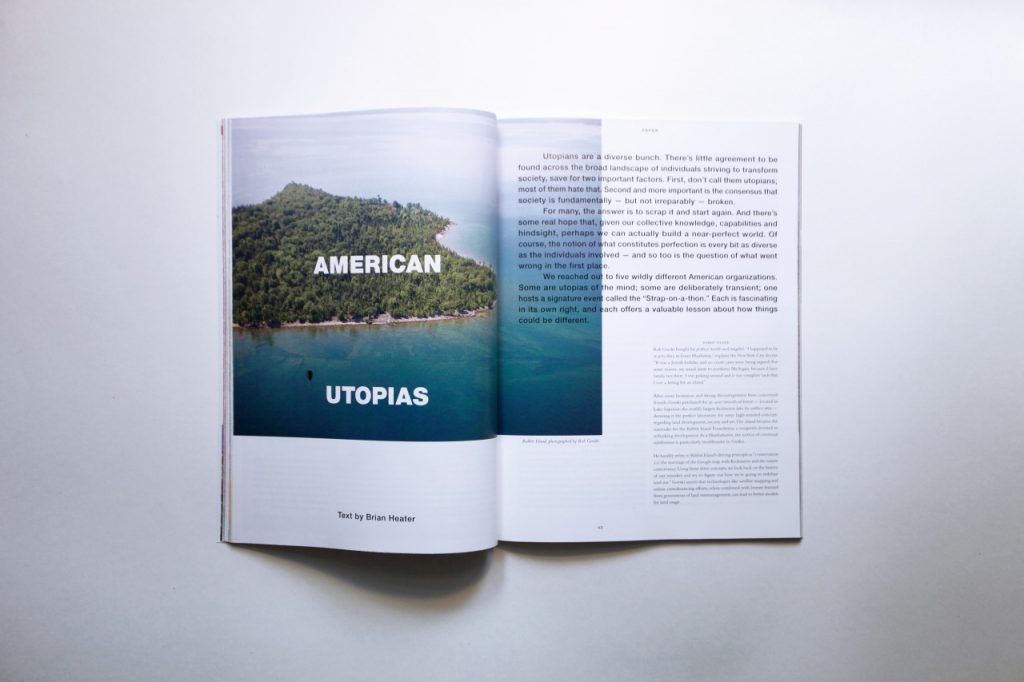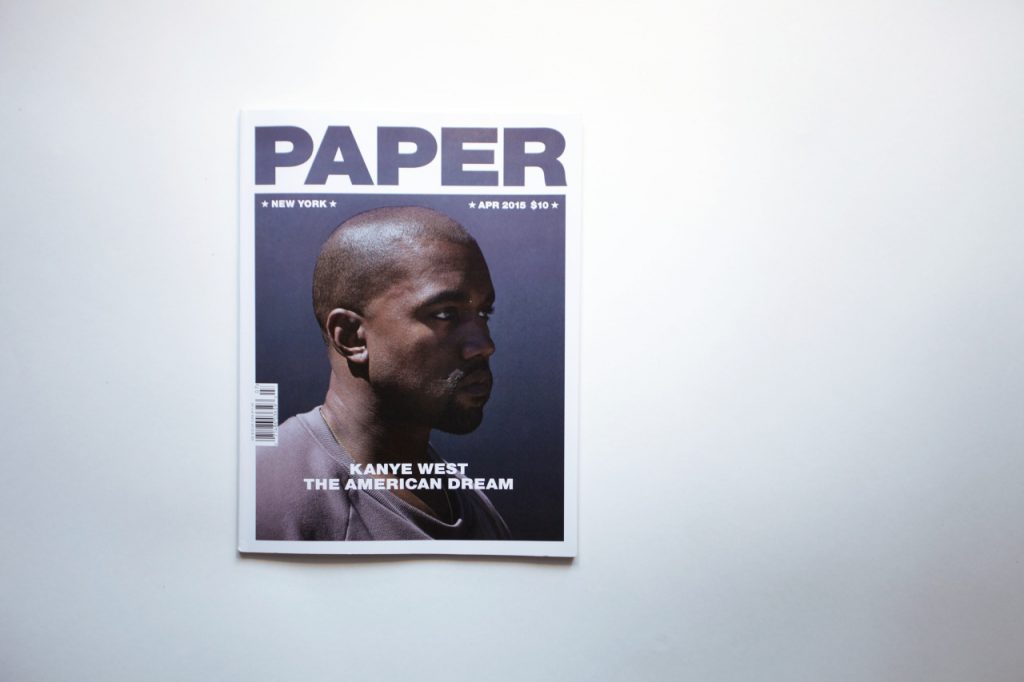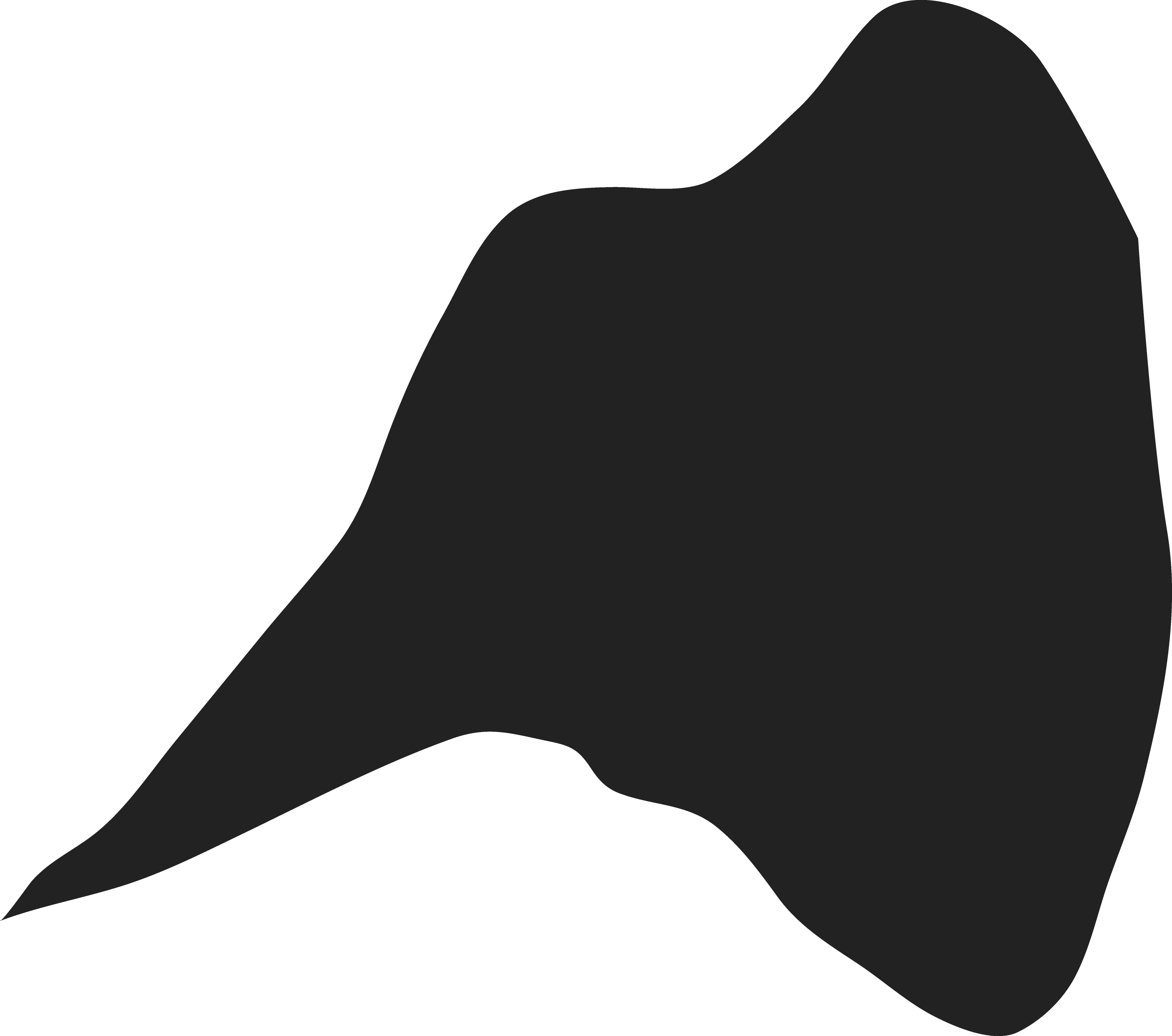
Reflections on Utopia: Paper Mag
Rob Gorski and Andrew Ranville
May 2015
Rabbit Island is featured alongside four other “American Utopias” in the April 2015 issue of the art and culture magazine Paper.
“Utopians are a diverse bunch,” the story begins. “There’s little agreement to be found across the broad landscape of individuals striving to transform society, save for two important factors. First, don’t call them utopians; most of them hate that. Second and more important is the consensus that society is fundamentally–but not irreparably–broken.”
On both points we agree.
Brian Heater, the author, goes on to describe the island’s wilderness character, the Rabbit Island Artist Residency, and some of the project’s cultural spinoffs.
After some hesitation and strong discouragement from concerned friends, Gorski [Rabbit Island’s owner and co-founder] purchased the 91-acre swoosh of forest–located in Lake Superior, the world’s largest freshwater lake by surface area–deeming it the perfect laboratory for some high-minded concepts regarding land development, society and art. The island became the namesake for the Rabbit Island Foundation, a nonprofit devoted to rethinking development. As a Manhattanite, the notion of continual subdivision is particularly troublesome to Gorski. He handily refers to Rabbit Island’s driving principle as “Conservation 2.0: the marriage of the Google map with Kickstarter and the Nature Conservancy.” Gorski asserts that technologies like satellite mapping and online crowdsourcing efforts, when combined with lessons learned from generations of land mismanagement, can lead to better models for land usage. … “I think that’s a microcosm for all the decisions that we should be making in our daily lives. What am I going to do today? What am I going to make today? What am I going to sell today? What am I going to buy today? And whatever I choose to do, how am I not going to fuck up everything around me?”
The issue’s cover feature, Kanye West, in his free-flowing take on the American Dream, contributes, “I believe awesome is possible and I believe that beauty is important. When I say ‘beauty,’ what’s your current definition of beauty? When I think beauty, I think of an untouched forest, only created by God’s hand.”
We agree here as well. Save the part about God as used in this context, of course.

However, this highlights some contradictions relative to artistic success in our culture that we believe are worth discussing. Many of the artists regularly featured in magazines such as Paper, elsewhere in popular culture, and in contemporary museum culture, have been graced with various degrees of celebrity as a result of stylish and/or important ideas they have conceived and brought into the world. However, the popularly accepted metrics of what is stylish and important–a phrase used here to signify that which is celebrated by critics, curators, and other cultural arbiters–have historically been dissociated from a thoughtful and holistic understanding of the physical world.
An interesting circle has been traditionally created: New Creative Idea. Fans. Celebrity. Success. Magazines. Museums. Repeat. Rarely in these progressions to artistic and societal success are references to ecology. Of course there have been celebrated and poignant examples of artworks engaging with ecological concerns in the last half decade or more, even those considered social before “social practice” was the art world’s stratégie du jour. Presently, it stands to reason that the hyper-connected and hyper-recycled creation and consumption of culture results in a danger of missing the truly profound. How is it that we can be so connected but still so detached, our feet rarely touching the soil, both literally and figuratively? Magazines like Paper might highlight celebrity inanity as much as thoughtful projects embedded in dirt and trees; but both now exist most readily on an Instagram feed, living and dying in influence and audience as the minutes pass. It appears participants in both camps universally value intact nature for what it is—as Kanye evidently does—regardless of whether their creations were working for or against it universally. It is an odd juxtaposition.
If many popular artists were to ask themselves the following question, what would their responses be?
Does your work positively influence the intelligent organization of our natural world in absolute terms? Does your work help in any way to mitigate the mistakes of cultural and environmental history we have inherited?
Modern understanding of our natural reality, as well as our cause-and-effect relationship to it, dictates a new ethical perspective. We must consider this when acting creatively, lest we risk acting selfishly in the absolute. A filter of modern knowledge needs to be placed between the classic spark of imagination and the contemporary execution of work. Until recently the making of art relied solely on the historical standards handed to us by tradition, experience, and education. From our new point of view, however, art history might be reviewed and re-ordered, and might lead to considerable reshuffling of what is actually considered important. God forbid one day $179.4 million dollars gets spent on re-furbishing an ecosystem, as an act of conscientious creation, rather than at an auction uptown.
In the end, of course, we can choose to do whatever we like creatively while presently limited only by what markets and laws will bear. We suggest, moving forward, that we should necessarily be judged according to a holistic understanding of ecological reality. If it is not artists pushing into this space, then who?
Revisionist history can only move so far into the present, with the evasive phrase “if we only knew then what we know now” falling flat in light of real-time understanding of global concerns. Neither artist nor politician can sidestep climate change, or food and energy shortages. Additionally, if we are forever contextualizing our work to important works and cultural moments of the past—a standard that auction houses and museums tend to value that lacks basic ecological and geo-spatial understanding—are we not bound to continually applaud ideas that don’t quite reach the level of true relevance in our own time?
We believe that new understanding of reality delineates new ethics within that reality. New work shouldn’t be defined by old ethics, nor by a limited understanding of natural reality, regardless of how entrenched this may be in our historical tradition. At some point we have to cut the cord. We need a new vantage point. We need a new set of rules.
Today, becoming a relevant artist is harder than in past times given the need to account for so much new and conflicting information, yet this is what is demanded of us. An artist, it is said, is meaningful to their time when they successfully express the undercurrents that shape their time. In the past it was the norm that one needed only to create something aesthetically beautiful, or brilliant, yet without account for its environmental cost, in order to inspire applause. In our time material ignorance is losing acceptance as evidenced by degree shows; headlines in major newspapers; and most importantly, the feeling we all carry around in our subconsciousness. The elements that make up the mediums used to bring an artwork to fruition are not decentralized, but rather finite nodes in our ecological reality. Each piece of plaster, pigment, celluloid, and circuit connects back to the physical world. And our comprehension of that world is expanding. The last twenty years have seen the dawn of the Internet, daily satellite perspectives of the world, concise understanding of watershed ecology, genetic understanding, migration patterns, and so forth. Our spectrum is much wider than it was in the 20th century. Our art must be too.
Perhaps this then signifies an end to the pre-conscious era of creation, where action without fundamental ecologic accountability was acceptable. As the spectrum widens and our understanding grows, should this not recalibrate old metrics related to perceiving and making art? Should not our conscience change to reflect the natural realities that we now understand to be true? Meaningful creativity is not impossible in this context, but it does require a new capacity for critical thinking relative to the beliefs, opinions and observations written above.
This is the premise of Rabbit Island. Our project is not “utopian,” as Paper suggested. It is simply rooted in an honest take on the modern world. It is an attempt to address cultural inconsistencies using creativity and reason. When finished—if it can ever be considered finished—our project will leave many more acres of forest organized sensibly and protected than when we started, in addition to the ideas we project outwardly from the experience. This absolute natural outcome could be looked upon by posterity as the most important thing that we will have created as a community, perhaps. Or perhaps we will have helped create a sensible cultural vernacular to move forward with. Regardless, our project is not afraid to call spades spades, especially in relation to the need for art to be coupled to ecology, and to be held responsible in absolute terms. Art, after all, is the purest form of creation, and thus serves fittingly as a symbol for all human constructions.
